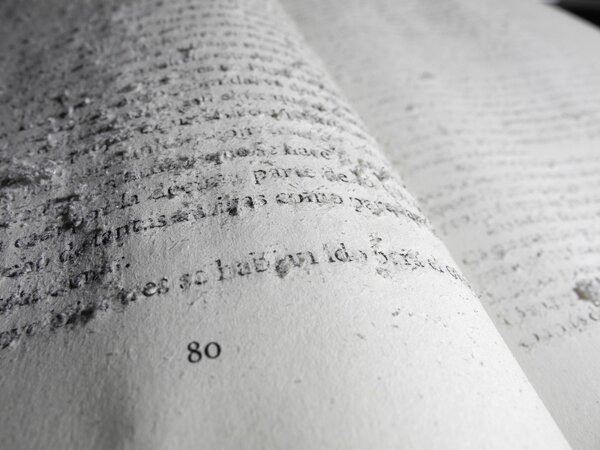Lifted out of its better-known life as a novel, Maridos (Husbands) by Angeles Mastretta is being shifted or rather erased by the artist Mariana Orozco into a form of visual poetry in which the book will be an artist book and object rather than a text.
Ulises Carrión the Mexican poet, artist and author wrote in his book The New Art of Making Books: ‘The most beautiful and perfect book in the world is a book with only blank pages, in the same way that the most complex language is that which lies beyond all that the words of a man can say.’
He also wrote a ‘rose’ is only your own ‘rose’ if taken out of the structure of a text. The creation of concrete poetry leaves words abstracted in a space that becomes ‘the music of the unsung poetry’.
By slowly scraping away text from the 300-page novel Orozco leaves words or sentences suspended in the space of absent words. The attributes of the book are transformed into Orozcos’ own concrete poetry. It is a book of stories about women’s lives and loves in contemporary Latin society. In Mastretta’s stories many of the women are caught in the midpoint of life by widowhood or divorce and often find new directions towards self-realisation. The hook of personal connection to those stories underlies Orozco’s assiduous reaction. With Orozco’s own path following divorce, abandonment of a high-powered career and a move to Barcelona in order to follow art it is easy to read an allegorical reflection in her artist book and she admits it is a cathartic process: ‘Sometimes I leave the conclusions, I erase the conversation and I leave the conclusion of it. It’s kind of like a solution, and its what I wanted to keep with me. It’s a cathartic thing to close the moment and also to talk about what it is to be a woman’. The gender issues rife in the texts chime with those decisions Orozco has had to make and she revealed: ‘I think the difficult thing for women is to have balance, to share moments with your husband and also not to lose yourself, this work talks about that’.
Each evening she sits for an hour or two, reading and reading the text, then using a knife scrapes away words to leave words and phrases that hold meaning for her, words such as ‘feliz’ or ‘nostalgia’ or the phrase ‘porque quien quiere la col quiere las hojas’ punctuate the empty pages. She started in September and by December was halfway through. Through a residency and grant in the spring she will be exhibiting her artist book in the Museo de Arte Abstracto Manuel Felguérez , Zacatecas, México in a group show titled ‘La Conversación’.
The final work will be the artist book, and whether a video of her arduous process is part of the final work remains to be seen. A meeting with the author herself is being arranged and the erasing of the book is increasingly becoming an event.
As Ulises Carrión articulated, what is left unsaid or blank can be the most complex or beautiful and in the context of the shell of ‘Maridos’ the silent space communicates as much as the archipelago of Orozco’s abstracted words.
- Share:
- Tweet
- Share on Tumblr





